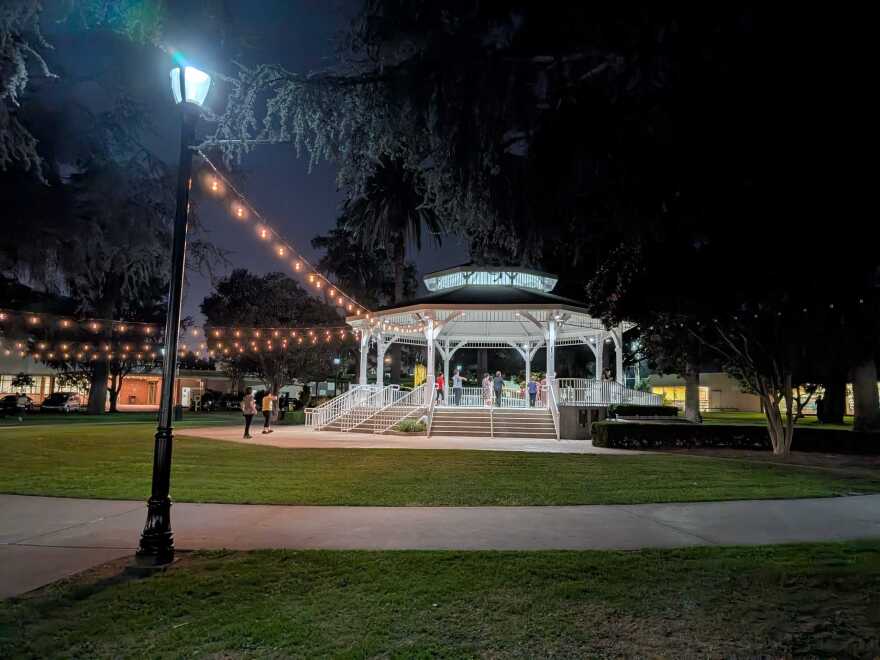Truth matters. Community matters. Your support makes both possible. LAist is one of the few places where news remains independent and free from political and corporate influence. Stand up for truth and for LAist. Make your year-end tax-deductible gift now.
Why Chinese immigrants are taking over parks in the San Gabriel Valley to dance

Getting lost sometimes leads you to unexpected destinations. Sometimes, it's to an entirely different country right in your own backyard.
A few weeks ago, I got lost driving through Temple City on my way to a place I have been many times. Twilight was setting in, enveloping everything in that quiet suburban darkness.
I made a turn down a side street next to what seemed to be a gigantic park — and heard the unmistakable sound of Chinese music blasting out of a boombox.
I pulled over and saw this.

Ten or so women were coming together to dance to Mandarin songs from an older era.
It's actually a scene I've seen before at parks and other open spaces in the San Gabriel Valley in the last few years.

A Chinese phenomenon
The first time I ever saw these dance gatherings, however, was in China about a decade ago. One of the country's key urban design features is its ginormous public squares — these endless concrete expanses of flat, open space that dot their cities.
One night, I came across a group of Chinese women dancing in unison at one of these open-air plazas, around 30 to 50 of them. I watched mesmerized as they strutted their stuff to one Chinese song after another coming out of a boombox.
They didn't look like they were rehearsing for a performance, or there for any other reason than for the pure joy and leisure of the activity.
"Plaza dancing" or "square dancing" (广场舞), as the phenomenon is known, emerged in China in the 1990s. Legions of mostly middle-aged and older women flock together extemporaneously to twirl and sashay for exercise and to stave off post-retirement boredom. In China, the legal retirement age for women is 50 or 55, depending on the type of work they do. Those limits will go up starting next year.
Bringing the steps to the SGV

In the San Gabriel Valley, where many Chinese-speaking immigrants have settled, the motivation that led this group of women to come together under a gazebo at a Temple City park was largely the same.
A 60-something woman in a polka dot dress who called herself Ah Yun said she's been dancing here for more than a decade, after learning about the scene through the grapevine.
"Someone told us that there was 'plaza dancing' here. We came to check it out," said Ah Yun, who lives in El Monte and is originally from Guangzhou.

She quickly became a regular, learning the steps from a woman who was leading these nightly gatherings. At their largest, as many as 100 women show up.
"You can do this alone. It's not like learning how to social dance, where you need two people," she said in Cantonese. "With this, no one cares if you are good or bad at it."
Ding Ding is from Shanghai. Before she immigrated to the U.S. about a decade ago, she said she occasionally joined others to dance publicly in that Chinese city.
One day, the 80-something said she was walking in Temple City and saw people dancing at the park. The ritual quickly became the outlet she looks forward to every day, so much so that she'd get dressed up and done up for it. Tonight, she was wearing a blue pattern dress.
Over the years, dancers came and went — but no one is ever turned away.
The ladies tonight were particularly excited, because the woman who started it all — whom they refer to as their "teacher" — was coming back to show the group a new number.

Their teacher is 73, sporting a baseball cap and a mask. She didn't want to give her name, but said she used to live around Temple City before moving away. She still comes back once a while to meet up with the group.
She told me that she unwittingly brought the trend to this park 13 years ago after moving from Northeastern China. She bought a portable music player, turned it on, and started dancing by herself.
Soon, women started to show up and asked if they could join. One after another the group built.
Ding Ding chimed in. "Basically, the environment here is so nice. It's perfect for dancing. That's what happened," she said in Mandarin.













